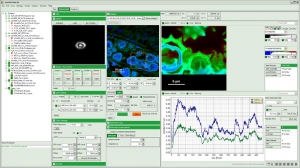Time-resolved Confocal Fluorescence Microscope with Unique Single Molecule Sensitivity Complete confocal system with laser combining unit, inverted microscope body, and multichannel detection unit Turn-key diode lasers for multicolor excitation from 375 to 900 nm Up to 6 truly parallel detection channels using application-optimized detection with SPADs, PMTs or Hybrid-PMTs Time-Correlated-Single Photon Counting (TCSPC) and TTTR mode for investigation of fast dynamics in FCS and FLIM Piezo scanning for 2D- and 3D-lifetime imaging and accurate point positioning Two optional exit ports for additional hardware, e.g. spectrographs Advanced easy-to-use data acquisition, analysis and visualisation software SymPhoTime 64 Unique upgrades to 2focus FCS, simultaneous AFM/FLIM, deep UV excitation STED add-on for super-resolution imaging available FLIMbee galvo scanner add-on with outstanding flexibility in scanning speed and excellent spatial precision scanning FCS available via line scan in x using FLIMbee galvo scanner
The advances of cutting edge science in many fields depend on single molecule studies. This includes, for example, the quantification of molecular dynamics or molecular properties as well as interaction studies in material and life sciences. Such a wide field of research requires a flexible instrument, which can be adapted to the individual needs. This versatility is given in the MicroTime 200, a time-resolved confocal fluorescence microscope system. This powerful instrument is ready to analyze a multitude of parameters down to the single molecule level using methods such as Fluorescence Lifetime Imaging (FLIM), FLIM/FRET, deep tissue FLIM, PIE, FCS/FCCS, FLCS/FLCCS, dual-focus FCS, scanning FCS, anisotropy, burst analysis, simultaneous AFM/FLIM or deep UV detection, to name only the most common. Even high resolution imaging with spatial resolutions below 50 nm is possible with the new MicroTime 200 STED add-on.
Flexible excitation subsystem
 The excitation subsystem of the MicroTime 200 consists of a pulsed diode laser driver of the PDL Series and different laser heads with pulses in the picosecond time regime (additional CW mode is available as an option). The available wavelengths range from 375 to 900 nm.
The excitation subsystem of the MicroTime 200 consists of a pulsed diode laser driver of the PDL Series and different laser heads with pulses in the picosecond time regime (additional CW mode is available as an option). The available wavelengths range from 375 to 900 nm.
The laser power and repetition rate can be flexibly adjusted by the laser drivers of the PDL Series. The multichannel laser driver PDL 828 "Sepia II" even allow to address several lasers in parallel enabling advanced techniques like Pulsed Interleaved Excitation (PIE).
The laser heads are integrated in one Laser Combining Unit (LCU) for easier handling, attenuation and coupling into an optical fiber. An alternative incoupling port at the MicroTime 200 can accommodate additional excitation sources such as Ti:Sapphire lasers for multi-photon excitation schemes. Using our dedicated Two-Photon-Excitation unit, the output from external lasers can be easily coupled to the main optical unit of the MicroTime 200.
Choice of scanning technologies
 The MicroTime 200 can be equipped with different devices for scanning an image: A galvo scanner for quick image acquisition or piezo devices for maximum flexibility in terms of usable wavelengths. The great versatility of the MicroTime 200 platform is complemented by the FLIMbee galvo scanner which can provide scanning speeds ranging from very slow to fast while maintaining high precision. This high degree of flexibility in speed allows for applications ranging from Phosphorescence Lifetime Imaging (PLIM) to fast fluorescence lifetime measurements using rapidFLIM. Furthermore, with its high precision and sensitivity, the FLIMbee scanner is optimally suited for super-resolution microscopy via STED, enabling imaging down to the single molecule level.
The MicroTime 200 can be equipped with different devices for scanning an image: A galvo scanner for quick image acquisition or piezo devices for maximum flexibility in terms of usable wavelengths. The great versatility of the MicroTime 200 platform is complemented by the FLIMbee galvo scanner which can provide scanning speeds ranging from very slow to fast while maintaining high precision. This high degree of flexibility in speed allows for applications ranging from Phosphorescence Lifetime Imaging (PLIM) to fast fluorescence lifetime measurements using rapidFLIM. Furthermore, with its high precision and sensitivity, the FLIMbee scanner is optimally suited for super-resolution microscopy via STED, enabling imaging down to the single molecule level.
A MicroTime 200 equipped with a FLIMbee scanner is a good choice for Single Molecule Detection (SMD) methods such as spFRET, PIE-FRET, (STED-)FCS, FLCS, FLCCS, dual-focus FCS (2fFCS), and even anisotropy measurements. Additionally, Two-Photon Excitation (TPE) with descanned and non-descanned detection is possible.
The core of the FLIMbee galvo scanner consists of three high precision oscillating mirrors with excellent linearity, repeatability and low drift. The two y-axis galvo mirrors ensure that the laser beam is stationary at the entrance of the objective. This mirror configuration minimizes vignetting of the image field and ensures a constant focal volume over a wide scan range. The FLIMbee scanner provides a minimal pixel size of 10 nm when using a 100x objective.
Use of the standard piezo scanner is recommended for applications requiring light from the UV (255 to 400 nm) and NIR (1100 to 1400 nm) spectral regions or when pixel sizes smaller than 10 nm are desired.
Detection subsystem with single photon sensitivity
 The MicroTime 200 was specially designed for single molecule studies and thus offers unique optics with vastly reduced light absorption. In this confocal microscope, scanning is facilitated through a piezo table optionally combined with a high precision PiFoc element for 3D imaging. The choice of piezo scanning ensures a high repositioning accuracy and stability, which is essential for single molecule studies.
The MicroTime 200 was specially designed for single molecule studies and thus offers unique optics with vastly reduced light absorption. In this confocal microscope, scanning is facilitated through a piezo table optionally combined with a high precision PiFoc element for 3D imaging. The choice of piezo scanning ensures a high repositioning accuracy and stability, which is essential for single molecule studies.
The MicroTime 200 can be configured for up to six individual detection channels. Each channel can be equipped with a different detector, chosen from a variety of sensitive detectors. The detectors offer ideal solutions depending on the wavelength to be detected, the signal brightness and the excited state lifetime of the investigated emitters. The choice of detectors include PMA Hybrid detectors, optimized SPADs for efficiency or timing as well as dedicated detectors for experiments in the deep UV.
Timing with picosecond resolution
 Time-resolved microscopy requires the registration of not only the photons themselves, but also their position in time and, for imaging, in space. The ideal technique for that purpose is the Time-Tagged Time-Resolved (TTTR) data acquisition developed by PicoQuant, which is an variation of the classical method of Time-Correlated Single Photon Counting (TCSPC). The advantage of TTTR data acquisition mode is that it allows to perform vastly different measurement procedures, like FLIM, FCS or even coincidence correlation ("antibunching"), based on just one fundamental data format. The TTTR format ist supported by all available TCSPC electronics from PicoQuant. Using these high-end integrated devices fluorescence lifetimes down to a few picoseconds or even up to ms for phosphorescence and luminescence studies can be easily resolved.
Time-resolved microscopy requires the registration of not only the photons themselves, but also their position in time and, for imaging, in space. The ideal technique for that purpose is the Time-Tagged Time-Resolved (TTTR) data acquisition developed by PicoQuant, which is an variation of the classical method of Time-Correlated Single Photon Counting (TCSPC). The advantage of TTTR data acquisition mode is that it allows to perform vastly different measurement procedures, like FLIM, FCS or even coincidence correlation ("antibunching"), based on just one fundamental data format. The TTTR format ist supported by all available TCSPC electronics from PicoQuant. Using these high-end integrated devices fluorescence lifetimes down to a few picoseconds or even up to ms for phosphorescence and luminescence studies can be easily resolved.
Intuitive data handling and analysis
 Based on the sophisticated data collection and handling, the system software SymPhoTime 64 supports a multitude of methods, such as intensity time trace, burst analysis, lifetime histogramming, Fluorescence Correlation Spectroscopy (FCS), Fluorescence Lifetime Correlation Spectroscopy (FLCS), Fluorescence Lifetime Imaging (FLIM), Förster Resonance Energy Transfer (FRET) and anisotropy, to name only a few.
Based on the sophisticated data collection and handling, the system software SymPhoTime 64 supports a multitude of methods, such as intensity time trace, burst analysis, lifetime histogramming, Fluorescence Correlation Spectroscopy (FCS), Fluorescence Lifetime Correlation Spectroscopy (FLCS), Fluorescence Lifetime Imaging (FLIM), Förster Resonance Energy Transfer (FRET) and anisotropy, to name only a few.
SymPhoTime 64 data handling maintains a transparent data structure where all derived data is maintained in one workspace, including a log file to keep track of all measurement and analysis steps.
A large number of algorithms for those methods are already integrated in SymPhoTime 64, providing a analysis platform for ready-to-publish data. At the same time, SymPhoTime 64 offers enhanced flexibility for the integration of novel, cutting edge algorithms by the user. A dedicated scripting language interface allows to modify and expand the analysis routines. In addition to data analysis within SymPhoTime 64, data can be exported to standard formats for external analysis.
Our interactive user forum as well as our regularly held SymPhoTime training days offer outstanding support for new and advanced users.
Scientific guidance and user training
 PicoQuant annually holds the European short course on "Time-resolved Microscopy and Correlation Spectroscopy". The course is intended for individuals wishing an in-depth introduction to the principles of time-resolved fluorescence microscopy and its applications to the Life Sciences. This 3-day event consists of lectures as well as instrumentation and software hands-on training. For details see the course website.
PicoQuant annually holds the European short course on "Time-resolved Microscopy and Correlation Spectroscopy". The course is intended for individuals wishing an in-depth introduction to the principles of time-resolved fluorescence microscopy and its applications to the Life Sciences. This 3-day event consists of lectures as well as instrumentation and software hands-on training. For details see the course website.
PicoQuant also hosts a forum that serves as a knowledge exchange platform for users of the company's systems, components and software packages.



 Download PDF
Download PDF Inquery Form
Inquery Form